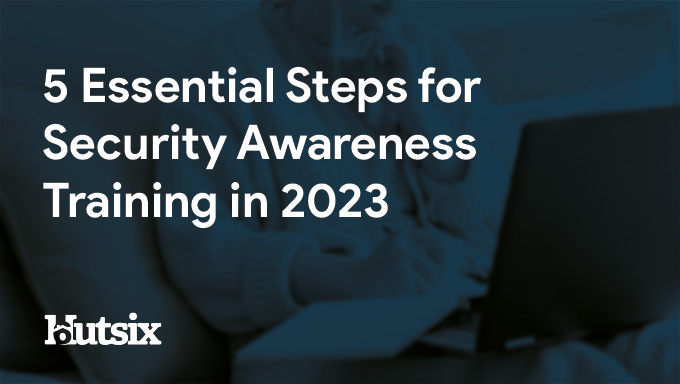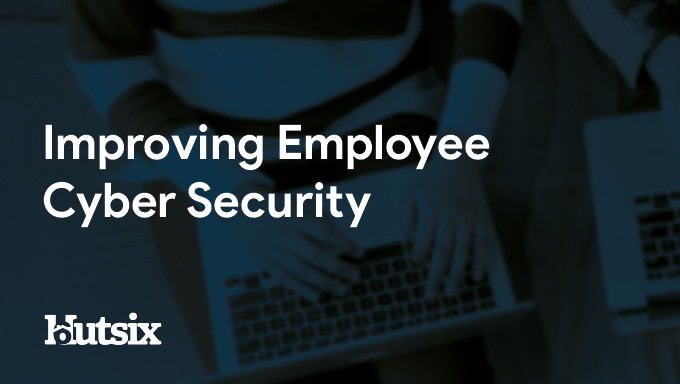What is Basic Security Awareness Training?
Basic Security Awareness Training is a critical educational programme designed to inform and educate employees about the various security threats they might encounter in the workplace.
Effective security awareness training helps to enhance the overall security posture of an organisation by empowering employees with the knowledge and skills necessary to identify, prevent, and respond to potential security incidents.
It covers fundamental concepts of cybersecurity, best practices for maintaining information security, and practical steps to safeguard sensitive data. By raising awareness and understanding of security protocols, employees become a crucial line of defence against cyber threats, ensuring the safety and integrity of organisational assets.
Looking to protect against cyber attacks?
Talk to one of our experts about effective training now.
What does Security Awareness Training Include?
Security Awareness Training encompasses a wide range of topics and activities designed to equip employees with the knowledge and skills needed to protect an organisation's information and assets. Comprehensive security awareness training typically includes:
Cybersecurity Fundamentals: An introduction to the basic concepts of cybersecurity, including common terminology and the importance of protecting digital assets.
Threat Identification: Training on recognising various types of cyber threats such as phishing, malware, ransomware, and social engineering attacks.
Best Practices: Guidelines on creating strong passwords, recognising suspicious emails, and safely browsing the internet.
Incident Response: Instructions on what to do if a security incident occurs, including reporting procedures and immediate actions to take.
Data Protection: Information on how to handle sensitive data, including encryption, secure storage, and proper disposal of data.
Physical Security: Tips for maintaining physical security in the workplace, such as securing workstations and preventing unauthorized access to office areas.
Regulatory Compliance: Overview of relevant laws and regulations that govern data protection and privacy, such as GDPR or HIPAA, and the organisation's policies related to these regulations.
Password Security: Strategies for creating and managing strong, unique passwords, using multi-factor authentication, and understanding the risks of password reuse and weak passwords.
By including these elements, security awareness training ensures that employees are well-prepared to contribute to the overall security of the organisation.
Read More: 15 Essential Cyber Awareness Training Topics for 2024
What is the Main Objective of Security Awareness Training?
The primary objective of Security Awareness Training is to cultivate a culture of security within the organisation. Effective security awareness training aims to empower employees with the knowledge and skills necessary to recognise and respond to security threats effectively. Key objectives include:
- Risk Reduction: Minimising the risk of security incidents by educating employees on how to identify and avoid potential threats, thereby reducing the likelihood of successful attacks.
- Compliance: Ensuring that all employees understand and adhere to relevant laws, regulations, and organisational policies regarding data protection and cybersecurity.
- Incident Preparedness: Equipping employees with the tools and knowledge to respond appropriately to security incidents, thereby mitigating potential damage and ensuring swift recovery.
- Behavioural Change: Encouraging positive behavioural changes by promoting best practices in security and making security considerations a routine part of daily activities.
- Protecting Assets: Safeguarding the organisation's physical and digital assets by fostering a security-conscious workforce that understands the value of these assets and the importance of protecting them.
- Building Trust: Enhancing the trust of clients, partners, and stakeholders by demonstrating a commitment to maintaining a secure environment for all interactions and transactions.
Read More: What is the Impact of Security Awareness Training?
By achieving these objectives, security awareness training not only protects the organisation from cyber threats but also promotes a proactive approach to security that benefits all aspects of the business.
Security Awareness Examples
Security Awareness Training can be enriched with practical examples that illustrate common security threats and appropriate responses. Real-world examples are an essential part of comprehensive security awareness training. Here are some examples that can be included in the training:
- Phishing Emails:
- Example: An employee receives an email that appears to be from their bank, asking them to click on a link to verify their account details.
- Response: The employee should recognise the signs of a phishing attempt, such as generic greetings, spelling errors, and suspicious links, and report the email to their IT department without clicking on any links or providing any information.
- Malware Downloads:
- Example: An employee is prompted to download and install a seemingly legitimate software update from a pop-up message while browsing the internet.
- Response: The employee should avoid downloading software from unverified sources and consult their IT department before installing any updates or new software.
- Password Security:
- Example: An employee uses the same password for multiple accounts, and one of those accounts is compromised in a data breach.
- Response: The training should emphasise the importance of using unique, strong passwords for each account and utilising password managers to securely store and manage passwords.
- Social Engineering:
- Example: An unknown caller impersonates an IT technician and asks for an employee's login credentials to "fix" a supposed issue with their computer.
- Response: Employees should be trained to verify the identity of anyone requesting sensitive information and to report any suspicious requests to their IT department.
- Physical Security Breaches:
- Example: An employee notices a visitor without a badge attempting to enter a restricted area.
- Response: The employee should approach the visitor to verify their identity and escort them to the reception area, or report the incident to security personnel.
- Data Protection:
- Example: An employee leaves sensitive documents on their desk overnight.
- Response: Employees should be trained to securely store sensitive documents in locked drawers or cabinets when not in use and to follow a clean desk policy.
- Incident Response:
- Example: An employee detects unusual activity on their computer, such as unexpected software installations or data transfers.
- Response: The employee should immediately disconnect their device from the network and report the incident to their IT department for further investigation.
Basic Security Awareness Training for Employees
Basic Security Awareness Training for employees is a crucial component of an organisation's overall security strategy. Cyber threats are becoming increasingly sophisticated, and the human element often remains the weakest link in the security chain. As such, it is essential for employers to invest in proper security training to ensure their workforce is equipped with the knowledge and skills necessary to safeguard the organisation's information and assets.
Investing in security awareness training yields numerous benefits. Firstly, it helps in reducing the risk of security incidents. Employees who understand the fundamentals of cybersecurity and can recognise threats like phishing attempts, malware, and ransomware are less likely to fall victim to these attacks. This proactive approach to risk management significantly enhances the organisation's security posture.
Moreover, proper training fosters a culture of security within the organisation. When employees are regularly educated about security best practices and the importance of data protection, they become more vigilant and responsible in their daily activities. This cultural shift not only improves individual behaviours but also promotes a collective commitment to maintaining a secure work environment.
Compliance with legal and regulatory requirements is another critical reason for investing in security awareness training. Many industries are subject to stringent data protection laws and standards. By ensuring that employees are aware of and adhere to these regulations, organisations can avoid costly fines and reputational damage associated with non-compliance.
Effective security awareness training also prepares employees to respond appropriately to security incidents. In the event of a breach, well-trained employees know the immediate steps to take, such as reporting the incident to the IT department and following established protocols to mitigate damage. This rapid response capability is vital in minimising the impact of security breaches.
Furthermore, investing in training demonstrates to clients, partners, and stakeholders that the organisation is serious about security. This commitment to maintaining a secure environment builds trust and confidence, which are essential for long-term business relationships and reputation management.
Security Awareness for your Organisation
Enjoyed our blog? Learn more about how Hut Six can help improve you security awareness with training and simulated phishing. Start a free trial now, or book a meeting with one of our experts.
Featured
What is the Impact of Security Awareness Training? - Hut Six
Discover the Impact of Security Awareness Training: Prevent breaches, foster culture, & build trust.
What is Personal Data?
Learn about personal data, its types, and significance in data protection. Explore general and special category data, as well as pseudonymised and anonymised data under the GDPR.
Who Does GDPR Apply To?
Who Does GDPR Apply To? And Other Data Protection Questions/ Information Security blog by Information security awareness provider Hut Six Security.
Does ChatGPT Pose a Cybersecurity Risk
In this blog post, we explore whether AI chatbots like ChatGPT pose a cybersecurity risk. We delve into the potential vulnerabilities and threats posed by chatbots, and discuss measures that can be taken to mitigate these risks. Read on to discover how you can ensure the security of your organisation's chatbot interactions.
How Do I Get Cyber Essentials Certified?
Learn how to obtain Cyber Essentials certification and enhance your organization's cybersecurity posture with our comprehensive guide. Our expert insights will help you navigate the certification process to meet the requirements for Cyber Essentials.
Essential Steps for Security Awareness Training
Starting a security awareness training campaign? Here are 5 essential steps to help ensure information security success.
Malicious Insider Threats - Meaning & Examples
Malicious insider threats can cause massive problems. Here we examine some of the motivations behind attacks and methods of detection organisations can use to reduce risk.
5 Biggest Breaches of 2022 (So Far)
Five of the biggest and most significant data breaches, hacks, and information security attacks of 2022 (so far).
Auditing for GDPR Compliance
Questions to consider when auditing your business or SME for General Data Protection Regulation (GDPR) compliance.
Improving Employee Cyber Security
With human error responsible for many breaches and attacks, we offer some helpful areas for improving employee security compliance.












